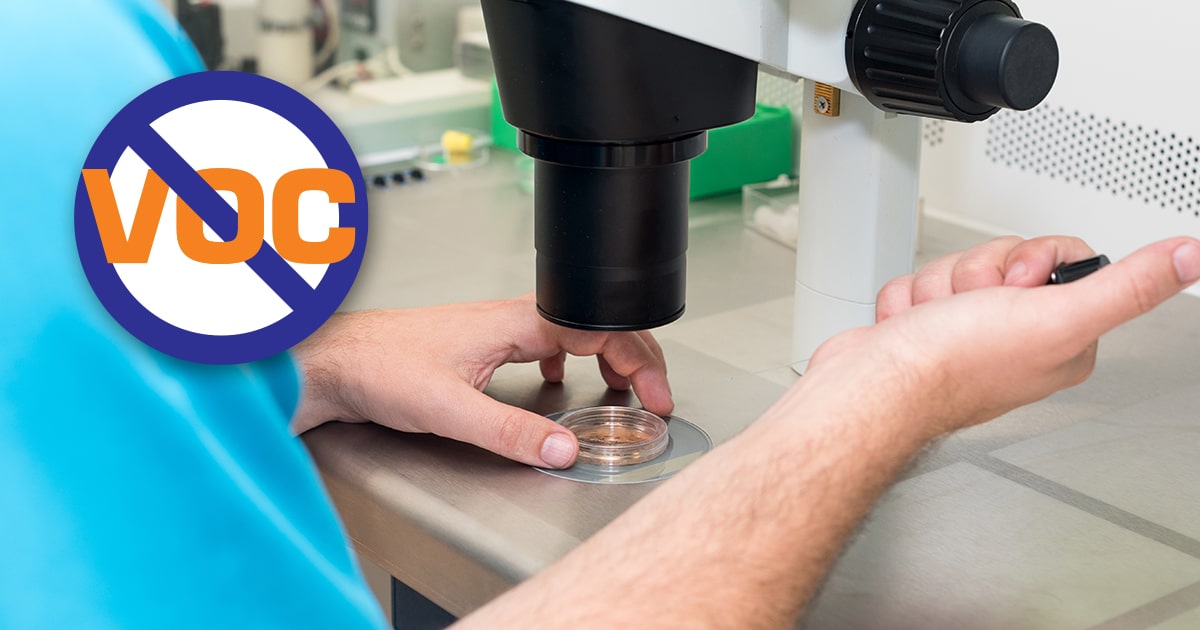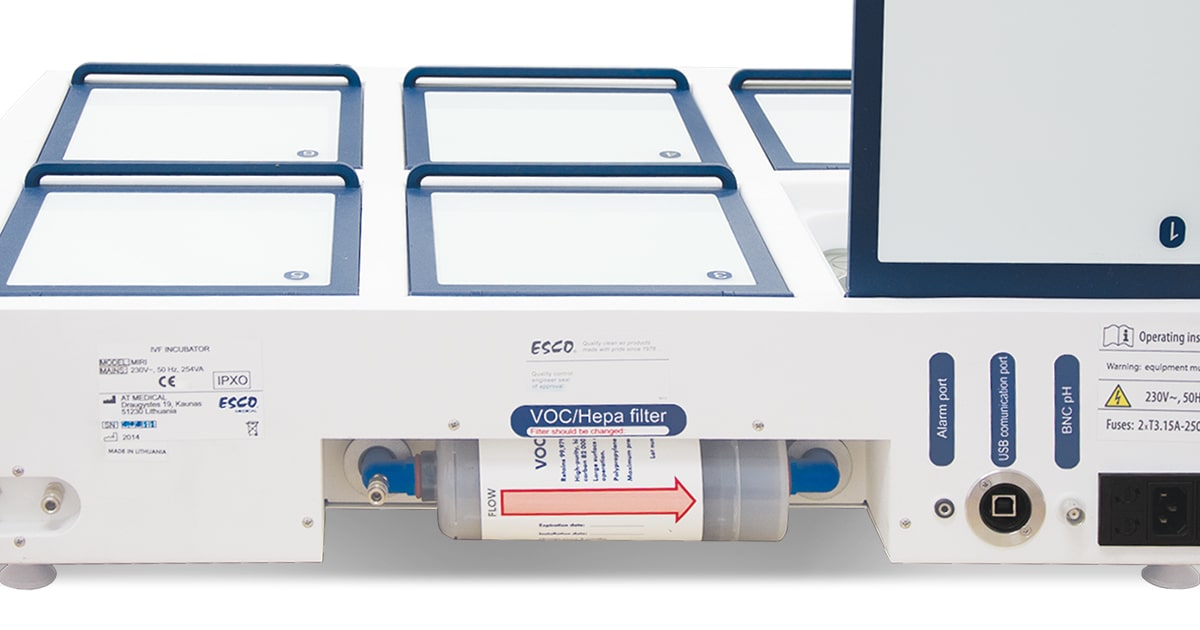Volatile Organic Compounds (VOCs) in an IVF Laboratory
.jpg)
Volatile organic compounds are substances with a high vapor pressure and little water solubility. Many VOCs are compounds created by humans and employed in the production of paints, drugs, and refrigerants. VOCs are often fuel oxygenates like methyl tert-butyl ether (MTBE), industrial solvents like trichloroethylene, or by-products of chlorination in water treatment like chloroform. Petroleum-based fuels, hydraulic fluids, paint thinners, and dry cleaning products frequently include VOCs.
Certain solids or liquids release volatile organic compounds (VOCs) into the air as gases. There are many different chemicals that make up VOCs, some of which may be harmful to your health in the short- and long-term. Several VOCs are constantly present in higher concentrations of indoor air than they are outside (up to ten times more). Thousands of different goods that span a broad spectrum release VOCs. VOCs include: paints and lacquers, paint removers, cleaning products, pesticides, building materials and furniture, office supplies like copiers and printers, correction fluids, and carbonless copy paper, as well as craft and graphic supplies like glues and adhesives, permanent markers, and photographic solutions.
IVF laboratory equipment and several household products or items contain volatile organic compounds as an ingredient. In addition to various cleaning, cosmetic, degreasing, and hobby items, paints, varnishes, and wax all include organic solvents. Organic chemicals make up fuels. All of these items have the potential to produce organic molecules both when in use and, to a lesser extent, when being kept.
No matter whether the residences were in rural or heavily industrialized locations, studies indicate that levels of around a dozen typical organic contaminants were 2 to 5 times greater inside homes than outside. Furthermore, while using goods containing organic compounds, people put themselves and others at very high risk for pollution, and higher levels of pollutants can linger in the air for long term.
Volatile Organic Compounds (VOCs) in an IVF Laboratory
Although an IVF laboratory may appear to be clinically sterile on the outside, it may nonetheless include VOCs from sources inside the lab, in nearby rooms, or even outside. An IVF lab may contain a variety of VOCs, such as formaldehyde, isopropanol, hydrocarbons like xylene, and refrigerant components. They can come from several places, such as medical gases, cabinets, instrument packs, building supplies, furniture, and carpets. The solid and liquid materials used in laboratory construction and finishing, lab equipment, cleaning agents, air fresheners, furniture, cosmetics, floor waxes, and cigarette smoke, to name a few, all emit VOCs as gases when they are burned. Airborne particles including skin cells, hair, and fabric fibers should be avoided because microorganisms may adhere to them as well.
Which is why, in the IVF laboratory, using an air filtration system that can remove both airborne particles and VOCs is essential.

The treatment of the eggs, sperm, and embryos outside of the body during the IVF procedure, in particular, exposes them to numerous harmful chemicals and airborne contaminants like VOCs. Although human embryos are incredibly resilient and able to adapt to their surroundings, exposure to VOCs may negatively impact IVF success rates.
VOC levels are also typically monitored in the clinical embryology lab utilizing portable direct reading devices and VOC probes. To offer a snapshot or an average exposure over time, short- and long-term sampling (during hours or days) can be used, respectively.
Volatile Organic Compounds (VOCs) at Home
Standard examples of volatile organic compounds that may be present in our daily lives are benzene, ethylene glycol, formaldehyde, methylene chloride, tetrachloroethylene, toluene, xylene, and butadiene.
There are a variety of sources of VOCs at home, such as building materials, and home and personal care products. These may include paint, varnishes, adhesives, carpets, certain types of flooring, composite wood products, cleaning products, cosmetics, fuel, and gasoline. VOCs may also arise from activities such as smoking, dry cleaning, cooking, and burning wood.
VOC Exposure and Health Effects or Implications
Each chemical that is inhaled poses a risk to one's health depending on how much is present, how long, and how frequently they are breathed in. The United States Environmental Protection Agency indicates that organic chemicals can have a wide range of health impacts, from those that are extremely poisonous to those with no known health effects. Some people's risk of developing health issues may grow when they breathe in low amounts of VOCs for extended periods of time.
These exposures are very distinct from occupational exposures. It's critical to keep in mind that VOCs are a collective term for a number of compounds. Each chemical has a unique toxicity and the ability to have a variety of negative health impacts.
Eye, nose, and throat irritation, headaches, nausea, vomiting, and dizziness are common symptoms of exposure to high levels of volatile organic compounds. Long-term exposure may also harm the liver, kidneys, and central nervous system.
VOC Build-up Management: Improving Air Quality
In the end, limiting and controlling VOC build-up in an IVF laboratory has shown to be the most efficient strategy to ensure that the facility is functionally competent while minimizing any negative effects on reproductive cells.
How to Improve Air Quality in an IVF Laboratory
There are a lot of ways to manage VOC build-up and improve air quality in a lab or at home.
HEPA and CODA Filters
High-efficiency particulate air (HEPA) filtration can be used to remove the majority of air pollutants that enter the lab. Anything smaller than 0.3 microns will be removed by these filters. Incubators, gas lines, and other work areas can be cleaned of hydrocarbons using CODA systems in conjunction with HEPA filters.
Room Separation or Segmentation
By separating the airflow between the clinical procedure room and the IVF lab with double-door gasketed pass-through windows, the positive pressure required for effective air filtering is maintained, and VOCs are prevented from moving from one space to another. To avoid contamination, it is also vital to keep the IVF lab separate from all other rooms, such as the storage, office, and diagnostic rooms, as well as the gas cylinder room.
VOC-free Paint
Formaldehyde may be included in paints, although depending on the manufacturer, if the concentration is less than 0.1% to 1%, it might not be mentioned as an ingredient. Use paints that are guaranteed to be VOC-free and don't have pigment added at the point of sale wherever possible.
VOC-free Cleaning Products
Despite being the preferred disinfectant in most laboratories, ethanol is a powerful VOC and an embryo poison. Hydrogen peroxide and diluted sodium hypochlorite solution (bleach) are chemicals that can be used in place of ethanol.
Off-gas Steel Furniture
Furniture that has been painted, shellacked, varnished, or shellacked may include binders that release formaldehyde into the air. The best option in an IVF lab is to off-gas (i.e., leave the furniture exposed to air for several days in a separate room) steel furniture that has been previously cleansed with isopropanol. If the furniture needs to be greased, a lubricant with a silicone base should be used.
Incubator Maintenance

Maintaining VOC-free incubators is essential since a contaminated incubator might negatively impact all embryo cultures. Incubators should be off-gassed, just like plasticware, and any maintenance or repairs should be carried out using low-VOC or off-gassed chemicals. In-line filters between the gas tank and the incubator as well as VOC-free gases should be utilized to reduce the total quantities of VOCs flowing through the incubators daily. By using incubators that can remove ambient air from the incubator and replace it with gases from the tanks, one may further verify that the lab environment is not a source of VOC contamination.
Monitoring VOC Levels
Gas chromatography and gas chromatography mass spectrometry are capable of detecting the majority of volatile organic compounds. It is possible to utilize photoionization detectors to gain a rough idea of the amount of VOCs present in the lab, but because they are unable to differentiate between VOCs, it is difficult to identify the source of contamination.